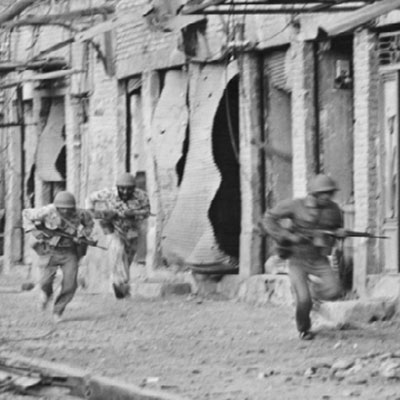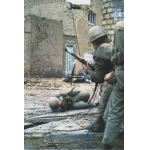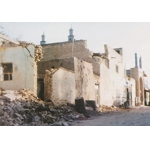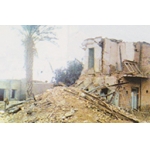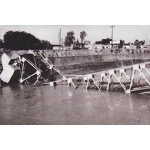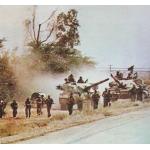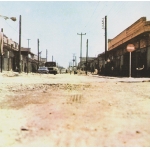Sites
Susangerd
Zahra Panbeh-Zari
315 دورہ
Susangerd is a city within the Khuzestan Province. It was captured by Saddam at the start of the Iraq-imposed war against Iran.
Susangerd or Susan[1] City is the center of Azadegan Dasht. It is also its most important city. The Karkhe River passes through the north and center of the city. Additionally, the Sableh and Malikieh Rivers branch off from the west and southwest of Susangerd.[2] This city was officially called "Khafajiyeh" until 1956, but the Arab population still know it by this name.[3] The residents of Susangard speak Persian and Arabic. They are Muslims who adhere to Twelver Shi’ism.
Dehlawieh, Hofel, Sarieh, North and South Albuafari, and Abu Hamizah are important villages of Susangerd.[4]
The existence of factors, such as agricultural land and the Karkhe River, were among the important reasons why Iraq chose to advance in this axis, wanting to attack the center of Khuzestan Province.[5] Therefore, on September 21, 1980, the Iraqi Army attacked the Azadgan Plain, and started its movement from the two axes of Chezaba and Talaiyeh.[6] Then, on September 28, it concentrated its efforts in Susangerd and captured it.[7] On September 29, Habib Sharifi, the first commander of the Susangerd Corps, along with his wife, Khadijah Mirshkar, were captured on the Susangerd-Ahvaz Road.[8]
On September 29, 1980, with the message of Imam Khomeini, "Are the youth of Ahvaz dead?!", the Guards formed a talented group of 28 people under the command of Ali Ghayurasli, who was in charge of the training of the Khuzestan Guards Corps.[9] Ali Ghayurasli was martyred in an operation that was later called "Ghayurasli.”[10]
Despite the liberation of Susangerd, this city was still under enemy artillery fire. After occupying Bostan (October 9, 1980), a unit of Iraqi forces went to the Hamidiyeh-Susangerd Road on October 13, 1980, and closed it. However, due to heavy Iranian artillery fire, the Iraqis retreated towards Howayzeh.[11] Four days later, on October 17, the armored forces of the Iraqi army attacked the Susangerd-Ahvaz Road, but they were forced to retreat.[12] A few hours later, they moved to Susangerd from the side of the Karkhe River and settled at a distance of 2 kilometers from Susangerd.[13]
On November 5, 1980, the advance of the Iraqi forces from the east and west towards Susangerd began, with people trying to evacuate the city. During one of Iraq's attacks from Sableh on November 10 and the resistance of Iranian forces in preventing Iraq's advance towards Sableh, Susangerd came under Iraqi artillery fire.[14]
The activities of the Iraqis to occupy Susangerd intensified from November 12, 1980. But their advance was halted when the Iranian forces confronted them, and they were forced to retreated.[15] On November 13, Iraqi forces advanced towards Susangerd from the west by occupying Dehlawiya[16] and entered Susangard on November 14.[17]
A few days later, in a meeting attended by the commanders of the army, the IRGC and the Irregular Wars Headquarters under the command of Mustafa Chamran, Imam's representative in the Supreme National Defense Council, Ayatollah Seyed Ali Khamenei, who was also Imam's representative in the Supreme National Defense Council, and the governor of Khuzestan, the plan for the siege of Susangerd was prepared.
Following the inconsist presence of the 92nd Ahvaz Armored Division for the liberation of Susangerd, Ayatollah Khamenei followed up on this issue and obtained the promise of assistance from Abolhassan Bani Sadr, the then President and Commander-in-Chief. Two days later, on November 14, when the previous promises were not fulfilled and with renewed follow-up, the 92nd Ahvaz Armored Division was tasked with breaking the siege of Susangerd, but this mission was also canceled on the same night by direct order of Bani Sadr. Knowing about this issue, Ayatollah Khamenei, based on Imam Khomeini's emphasis for the liberation of Susangerd, sends the command of the operation to the army command.[18]
Thus, on November 16, 1980, at 06:30, the operation to liberate Susangard began, and at 11:00, the first batch of Iraqi tanks fled to the south.[19]
Following the martyrdom of the city’s people and guards, Iraq attacked the hospital and massacred the patients within in it. The Khuzestan Region 8 Corps declared two-days of public mourning on November 15 and 16.[20] After this retreat of the Iraqis, they did not stop moving and on November 22, 1980, started their advance from south to north with the intention of capturing the Hamidiyeh-Susangerd Road, which was met with resistance by the IRGC forces.[21] Two days later, i.e. on November 24, Iraq advanced from the other side to try and seize the Hamidiyeh-Susengard Road, but failed.[22]
The Iraqis were active in the south of the Hamidiyeh-Susangerd Road until the middle of December 1980, but they never managed to achieve their goals.[23] On March 16, in order to destroy the Iraqi forces in the west of Susangerd, a battalion of forces went into action and confronted them in Operation Imam Mahdi.[24]
From May 21 to May 25, 1981, Operation Imam Ali, which was the first joint operation between the army and the IRGC, was carried out in the north of Karkheh and west of Susangerd. In this operation, the Iranian forces pushed the Iraqis back to three kilometers from Susangerd by advancing towards the west.[25] This operation was planned and executed with the aim of securing the city of Susangerd.[26]
On the morning of November 29, 1981, in the west of Susangerd, another operation called Tariq al-Quds took place. In this operation, which was the first operation aimed at pushing the enemy to the border point of Chezabe Strait, a large part of Iran's territory was liberated.[27]
Other operations that were carried out in Susangerd were Operation Shaheed Ibadat on May 1, 1981, Operation Rostami on June 16, 1981,[28] Operation Nasr on September 1, 1981 and Operation Madani on September 12, 1981.[29]
In December 1986, a large part of Susangerd was destroyed in an aerial bombardment. In this bombing, almost 80 percent of urban, educational, economic and civil buildings and facilities were destroyed, 700 people were martyred and injured, and many people fled to other cities.[30]
After this attack, Susangerd was rebuilt in 2 years with the efforts of the residents and the help of the Iranian people.[31] In the report on the activities of the reconstruction and renovation headquarters of the war-torn areas, it was stated about the damages in Susangerd that 80 units suffered 20-50% damage and 2245 units were destroyed with 50-100% damage by Iraqis forces.[32]
Following Imam Khomeini's order regarding the reconstruction of war-torn areas and the movement of people, an organization was formed for this purpose.[33] The people of the provinces all over the country also took responsibility for the reconstruction of a part of the war-torn areas, and this action was formed under the supervision of an organization called "Specified Headquarter". The Deputy General Staff of Mazandaran province undertook the reconstruction of Susangerd City and completed it.[34] In this program, nearly 2000 residential units were renovated, which was done through the people of Mazandaran and without the help of the government.[35]
[1] Tarabi, H., Azadegan plain in eight years of holy defense, Qom: Nasim Hayat (in collaboration with Sarir publication affiliated with the Foundation for the preservation of works and publishing the values of holy defense), 2005, p.19.
[2] Maleki (and others), G., Explanation of the failure of the siege of Sosangard, Tehran: Dafos, 2015, p. 109.
[3]Tarabi, H., Azadegan plain in eight years of holy defense, p. 20.
[4] Habibi, A., Satin Guide., Volume 4: Azadegan Plain in War, Tehran: Sacred Defense Documentation and Research Center (Islamic Revolutionary Guard Corps War Studies and Research Center), 2011, p.14.
[5] Eslami, S., Reconstructing something like war in Susangerd, Sari: Saro Sorkh, 2015, p. 30.
[6]Habibi, A., Satin Guide, Vol. 4, p. 36.
[7] Tarabi, H., Azadegan plain in eight years of holy defense, p. 311.
[8] Alizadeh, A., To Half Way, Mashhad: Shamshad, 2014, pp. 74 and 82; Babaei, Gol-Ali, A piece of the sky: Susangard, Tehran: Sa'eqa, 2013, p. 17.
[9] Satin Guide, Vol. 4, pp. 45 and 46.
[10] Ibid, p. 46.
[11] Ibid, p. 50.
[12] Ansari, M., Yekta, H., Iran-Iraq War Chronicle, Book IV: The Nationwide Invasion, Tehran: Holy Defense Documentation and Research Center (Islamic Revolutionary Guard Corps War Studies and Research Center), Ch II, 1996, p. 429
[13] Ibid, p. 474.
[14] Lotfollahzadegan, A., Chronicle of the Iran-Iraq War, Book 5: Hoveyzeh, the last steps of the occupier, Tehran: Center for Documents and Research of the Holy Defense (Center for Studies and Research of the War of the Islamic Revolutionary Guard Corps), 1994, pp. 129 and 162.
[15] Ibid, p. 198.
[16] Ibid, p. 205.
[17] Ibid, p. 216.
[18] Lotfollahzadegan, A., Journal of the Iran-Iraq War, book 5: Hoveyzeh, the last steps of the occupation, 1994, pp. 229 and 230; Imam Khomeini's book, vol. 12, Tehran: Imam Khomeini Editing and Publishing Institute, 1378, pp. 281 and 282.
[19] Habibi, Abu al-Qasim, Guide Atlas 4, Azadgan Plain in War, p. 61.
[20] A piece of the sky: Susangerd, pp. 58 and 59
[21] Guide Atlas, vol. 4, p. 64.
[22] Ibid, pp. 64 and 65
[23] Ibid, p. 65.
[24] Ibid., p. 81
[25] Khameyar, M., The firsts of the holy defense, Qom: Rahpoyan, 2013, pp. 109 and 110.
[26] Dari, H., Satin Guide, Volume 5: Record of Land Battles, Tehran: Sacred Defense Documentation and Research Center (Islamic Revolutionary Guard Corps War Studies and Research Center), 2002, p.76.
[27] Khameyar, M., the firsts of the holy defense, Qom: Rahpoyan, 2013, pp. 113 and 114.
[28] Dari, H., Guide Atlas, Vol. 5: Record of Land Battles, p. 70.
[29] Ibid, p. 68.
[30] Tarabi, H., Azadegan plain in eight years of holy defense, p. 21.
[31]Ibid, p. 68.
[32] Islami, S., Reconstructing something like war in Susangerd, p. 53
[33] Ibid. p. 56.
[34] Ibid, pp. 58 and 60.
[35] Anonymous, Susangerd, the city of martyrdom lovers, Reconstruction and Modernization Headquarters of War-Torn Areas of Mazandaran Province, Kilishe and Graver Industries, 1984.




